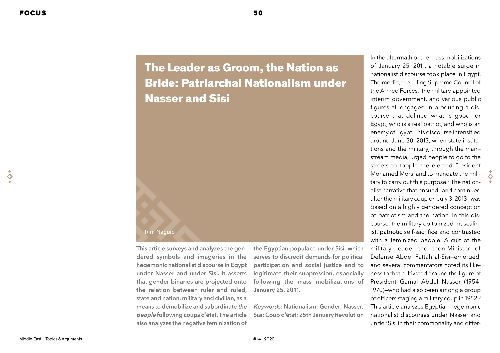The Leader as Groom, the Nation as Bride. Patriarchal Nationalism under Nasser and Sisi
This article surveys and analyzes the gendered symbols and imageries in the hegemonic nationalist discourse in Egypt, under Nasser and under Sisi. It advances that gender binaries are projected onto the relation between ruler and ruled, state and nation, military and civilian, as a means to demobili...
I tiakina i:
| I whakaputaina i: | Middle East - Topics & Arguments |
|---|---|
| Kaituhi matua: | |
| Hōputu: | Artikel (Zeitschrift) |
| Reo: | Ingarihi |
| I whakaputaina: |
Philipps-Universität Marburg
2020
|
| Ngā marau: | |
| Urunga tuihono: | Urunga tuihono |
| Ngā Tūtohu: |
Kāore He Tūtohu, Me noho koe te mea tuatahi ki te tūtohu i tēnei pūkete!
|
Ipurangi
Urunga tuihono| Tau karanga: |
urn:nbn:de:hebis:04-ep0003-2020-240-82328 |
|---|---|
| Rā whakaputa: |
2020-07-13 |
| Lizenz: |
http://creativecommons.org/licenses/by/4.0 |
| URL Uru: |
https://archiv.ub.uni-marburg.de/ep/0003/2020/240/8232 https://doi.org/10.17192/meta.2020.14.8232 |
